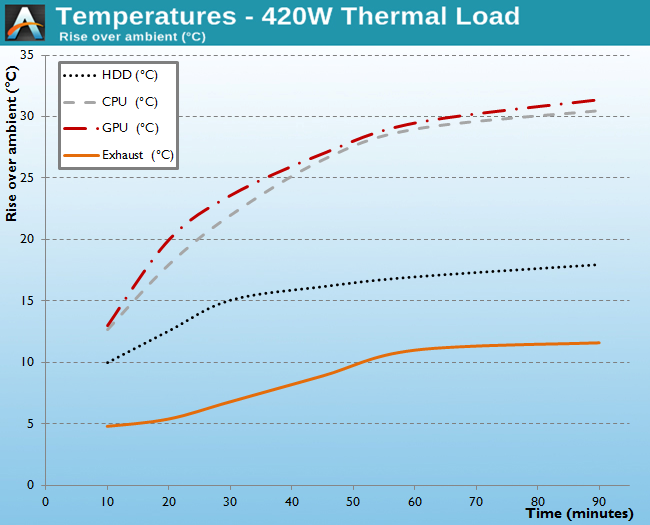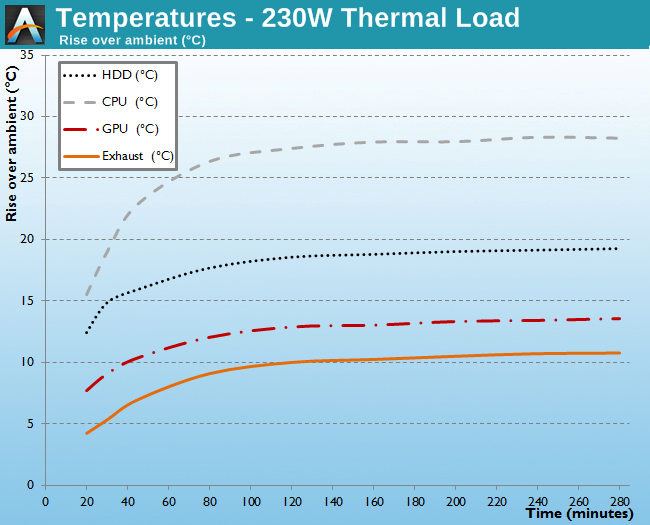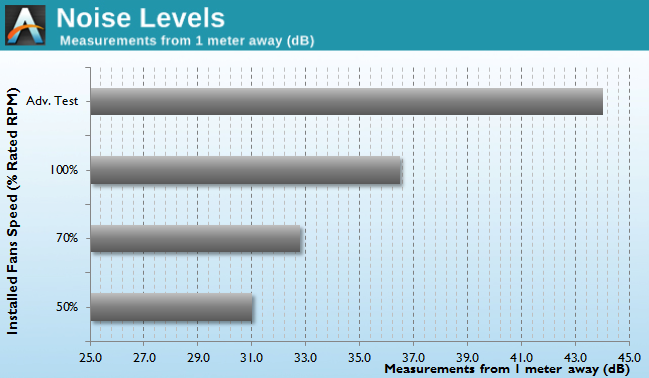Corsair Carbide Air 240 Case Review
by E. Fylladitakis on August 15, 2014 6:00 AM EST- Posted in
- Cases/Cooling/PSUs
- Corsair
- ATX
- Case
- Carbide
Test Setup
Professional testing requires the emulation of real-world situations but with repeatable results; thus, a perfectly controllable test setup and environment are required, especially for comparable results. Testing the thermal performance of any case with a typical real-world setup technically limits the comparability of the results to this setup alone, as an active system interacts with its environment and the change of a single component would alter myriads of variables. For our case reviews, we developed synthetic loads that emulate the thermal output of real systems, but these are passive, steady and quantifiable loads. This allows us to test the thermal capabilities of the case alone, as if it would have to deal with the entire thermal load by itself, regardless of what system an end user might install in it.
Laboratory data loggers are used to monitor the PT100 sensors and control the safety relays, which are fully accessible via our custom software. We have created three such loads, and we'll use the Micro-ATX load for this case. The Micro-ATX version simulates a 180W CPU, 40W VRM, 20W RAM, and 1 × 120W GPU card thermal load. Finally, two 3.5" HDD dummy loads have also been installed, with each of them converting 30W of electrical power to thermal. Note that the total load is generally more important than the individual elements, and the total thermal load of the Micro-ATX test setup is up to 420 Watts. As such, the thermal load is very high and only the best of cases will be able to handle it for more than a few minutes. For comparison purposes, we are also performing a test with a thermal load of 230W by reducing the CPU load to 90W, removing one disk load and using a low-profile, 50W version GFX load.
Thermal testing is performed with all of the case's stock fans operating at maximum speed. Standard noise testing has been performed with a background noise level of 30.4dB(A). Advanced noise testing is also being performed, in order to assess the ability of the case to dampen the noise of the components installed inside it. This includes the installation of two noise-generating sources (strong fans) inside the case, one positioned approximately over the first expansion slot and one over the CPU area, which generate ≈ 44.2 dB(A) when unobstructed. During the advanced noise test, all stock cooling options of the case are disabled.
Results and Discussion
As we expected from a case designed for ventilation, and despite its relatively compact size, the Carbide Air 240 displays exceptional thermal performance, significantly superior to that of the Mini-ITX Obsidian 250D. Although a direct comparison is not really possible, as the GPU load we use to test ATX cases is much higher, it would appear that the Carbide Air 240 has little to be jealous of Midi-ATX cases as well, delivering CPU and HDD temperatures that can easily rival cases such as the XFX Bravo 01 and Corsair's own Obsidian 450D.
The three stock cooling fans of the Carbide Air 240 are fairly weak, but that also has a positive effect on the acoustic performance of the case. With only the stock cooling fans installed, the Carbide Air 240 is a relatively quiet system, which can be made entirely quiet by simply connecting the fans onto the motherboard headers and leaving their speed control up to the BIOS. However, due to its design, the Carbide Air 240 cannot dampen the noise of the components installed inside it. Our testing revealed nearly zero noise-dampening capabilities, which is true of any case with so many openings on all sides.













63 Comments
View All Comments
MichaelD - Friday, August 15, 2014 - link
I've been looking for a small-ish case to build my new gaming PC in and this was looking so promising, until I saw that it has no 5.25" bay. For a daily-use PC at least one optical drive bay is mandatory. Some of us actually still buy our games on physical DVDs and it's nice to be able to burn a DVD or CD when you need to.kmmatney - Friday, August 15, 2014 - link
Between my wife and 3 kids, and work, I have 10 computers in the house, and most of them share an external USB drive - and the need for that is rare. it would be nice if this supported a slim optical drive, though - those take little room.brbubba - Friday, August 15, 2014 - link
I thought the same thing about my Air 540 because my water reservoir takes up the two 5.25" bays, but now that my DVDRom/CDRom is gone I haven't missed it. If you are still living in the 90's and haven't made the switch to Steam then just rip ISOs of all your games.romrunning - Friday, August 15, 2014 - link
Take a look at Silverstone's SUGO series - specificially the mini-ITX SG05 model. It can take a very decently sized GPU, and you can buy the case with a 450W PSU. It has a 5.25" slot for a slimline SATA disc drive; buy the slimline SATA power adapter cable 'cause they don't include it. The Silverstone case is also significantly smaller than this case. Great gaming case for a single GPU!I bought it, and I love it. I use the disc drive for when I buy CDs on sale; it's cheaper to get whole CD of 11-14 tracks when on sale than it is to buy individual tracks as MP3 downloads. I can then rip the whole disc & add it to my music library.
Grok42 - Saturday, August 16, 2014 - link
Mandatory? I'm not sure that word means what you think it does. Do some people still buy physical media? Sure, but I can't understand why. Every game is available online and it doesn't require you juggle disks when changing games. If you don't have good Internet I could understand but then just use an external drive. Rip them as ISO files so you don't need it connected all the time. It really isn't that difficult. You can upgrade more important parts of your system with the $20 you save.hapkiman - Friday, August 15, 2014 - link
I really like my Air 540, in fact its been the best case I've ever had. This one looks like its just going to be too cramped in there for good airflow. Plus its too wide to fit under an entertainment center.I'm not sold on this one.
brbubba - Friday, August 15, 2014 - link
"We cannot really claim that it is a unique case, both because many cubic cases are available"ORLY?
SirGCal - Friday, August 15, 2014 - link
I don't understand the non-need for an optical drive. I use mine for system images, backups, etc. I constantly use it nearly every day. Not to mention just to watch a movie while I'm working... Even on my laptop, I use the optical drive with some regularity. External drives never have interested me but with a case this huge, why isn't there one slot somewhere, even on the side? I just don't get it. I also have micro-ITX builds, smaller then this, but they still have an optical drive.SirGCal - Friday, August 15, 2014 - link
err Micro-ATX and Mini-ITX. I actually have both right now. Not a fan of the ITX honestly. One PCIe seems to be a problem when I want to use a PCIe SSD setup along with a deticated GPU. But that's another topic. Still, micro builds, for many of us, still need optical drives just for daily usage.ZeDestructor - Saturday, August 16, 2014 - link
For most people, backups, system images and all manner of not commonly accessed data (like movies, game installer and the like) goes on external drives or NAS boxes, if only for the convenience.Meanwhile, a 100pc DVD-R spindle costs $23.68, which works out to $94.72 for ~2TB. A single 2TB 7200rpm HDD costs $93. In addition, the HDD is faster, rewritable and takes significantly less space, and much more convenient since you don't have to swap disks as often.
Just yesterday I was helping a friend wrap up his NAS4Free install with ZFS (inside ESXi, fuck you VMware for removing RDMs from the vclient ui!), something he's doing to get a nice, always on, accessible anywhere library of media, mostly so that he can brick his PC(s) while watching movies on his projector.